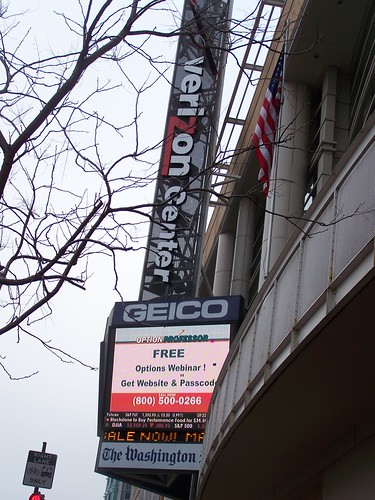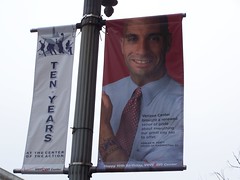You can honor people without vastly overstating the facts or going over the top
(Flickr image of MCI Center by by kmf164.)
Yes, Verizon Center contributed significantly to the revitalization of the "East End" of Downtown. But it is by no means all due to Abe Pollin, despite the encomium to him in today's Post, "Pollin Has Always Seen the Potential," by sports columnist Mike Wise.
Call the area "Pollin Quarter," after the owner? Please. That's as bad as calling the entertainment part of H Street NE "the Atlas District" or the neighborhood south of Florida "SoFlo" when Florida Avenue is otherwise not a distinguishing characteristic that significantly defines the neighborhood.
One of the reasons that 7th Street NW is successful is that it is the longest stretch of historic buildings remaining extant downtown, that simultaneously maintain the historic rhythm of storefronts.
It also matters that there are other anchors in the area (a/k/a critical mass or layering), especially the Smithsonian Museums.
The Jaleo Restaurant helped revitalize 7th Street NW long before the Verizon Center was on the scene. And since people eat every day you can't understate the significance of this restaurant as well as the other restaurants opened by the same company in the Penn Quarter.
And why is it that most of the retail/restaurant businesses actually located within Verizon Center have failed over the years?
Another problem is that the events are scheduled early, which "encourages" people to go directly to the Arena after work, and not spend money in area restaurants and stores before the game, but instead spend such dollars in the Arena. So the kind of spillover benefits that in the old days could happen in the area around a sports facility (think Wrigleyville in Chicago or the area around Fenley Park in Boston) but doesn't necessarily happen (most baseball and football stadiums) don't happen for the most part, except for events held on Fridays--people will stay out later after the game--or Saturdays--people will stay out later after the game and/or go out beforehand.
I do think that the Verizon Center succeeds in part for reasons similar to how Madison Square Garden is in the heart of the city and well served by transit in New York City.
Yes, I admit that the Verizon Center helps bring about "sampling" of the city by suburbanites and others who go to the game.
But the housing in the area, other retail (which largely isn't supported by attendees of events held in Verizon Center), and other attractions also contribute, and they contribute for far more days of the year and far more hours each day than events held inside of "that building."
Not to mention that development would have happened in the East End, to some extent, anyway, because of the elimination of any substantive land inventory available for redevelopment in the rest of the "Downtown."
Also see these past blog entries on the same topic:
-- MCI Arena as a way to re-engage suburbanites (11/2005)
-- Did MCI Center really miraculously improve DC's east end? (12/2005). If you read any of these entries, read this one
-- An interesting look back in time: Transformation in revitalization (9/2006)
-- Layering, location, and business failure as an indicator (12/2006)
-- Linkage + Complexity (11/2007)
One interesting thing about the Washington Times is that it appears as if they have assigned Tim Lemke, who used to report on business issues for the paper, to cover business-related sports issues. His articles are good. The Post needs someone to cover the same kind of beat. Tom Boswell does a decent job with sports-business issues, but he doesn't write about them all that often.
See Lemke's blog, "SportsBiz - Sports Business Commentary - Washington Times." And these articles from the Post, "Verizon Center Ticket Tax to Rise to 10%," "Verizon Center Operator Presents Case for D.C. Aid," and "Verizon Center To Prohibit Fans Bringing in Food."
Labels: building a local economy, economic development, mixed use, sports and economic development, urban design/placemaking, urban vs. suburban





0 Comments:
Post a Comment
<< Home